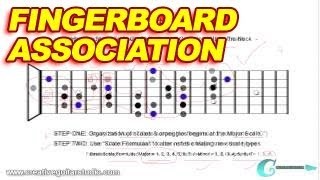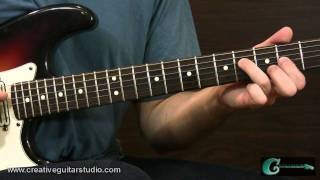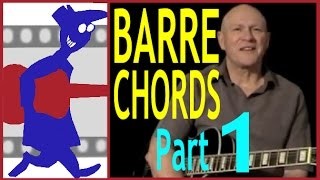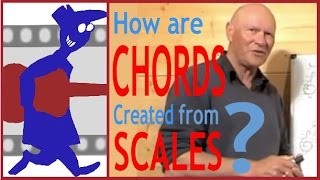Linking chords with bass notes
Published on 26 January 2016
For more information from the source site of this video please visit: http://secretguitarteacher.com/youtube/intermediate/acoustic/W32dtfCDzLM/84455346-linking-chords-with-bass-notes.php
This is a sample lesson from the Secret Guitar Teacher website (see link above).
IT IS NOT FOR BEGINNERS
It is aimed at intermediate guitarists who have already learned a few chord shapes and are now looking to improve their strumming hand technique.
Here is the abridged transcript:
When you first start strumming chords on the guitar there's a tendency to strum pretty much all six strings pretty much all the time, maybe a bit like this.
But gradually, as you begin to overcome the pain and discomfort in your fretting hand you start really listening to the sound you are making. Then a number of things start happening.
Firstly, almost without consciously trying, you will tend to get more exacting with how you place your fretting hand fingers. Going from this sort of sound...
...gradually to something more like this...
Then, once you're satisfied that the fretting hand is beginning to do what it is supposed to, there is a natural tendency to put some attention on the strumming hand.
A very common mistake is to put too much attention, too soon, on strumming or picking patterns.
What I am going to ask you to try to do in this lesson is to begin to add some single string work into your strumming, but, crucially, to do so without interrupting the flow of your strumming.
...and what I want you to do is to gradually thin out the bass end of the strumming until you are mostly just hitting the fifth string
The reason I have chosen the fifth string for the Am chord is to isolate the root note. The root note of any chord is simply the note the chord is named after.
This diagram shows you where to find the root notes for the main open A chords. A major, Am and A7. Right now, we are interested in the lowest root note and as you can see, for all three chords this is the Open A string note.
If I then change to C, I want to pick out the C root note
Notice that as I change from C back to Am the bass note changes even though I am still using the same string -- the fifth string.The note is changed by the fretting hand changing chord shape...
Now lets add in a G chord...Notice that this time we need to find the root note on the 6th string...
Now we'll just string these changes together...
That already sounds a lot smarter than just strumming doesn't it? Next step is to try this out with all the other open chords you know.
Once you have made yourself familiar with the root notes of your favourite chords and got used to picking them out as bass notes, the next step is to start linking your bass notes something like this...
If you are more left-brain inclined then simple logic can also be used to select which notes to use to link your bass notes.
For example if the bass note of the first chord is A ...and that of the next chord is C, you could ask your self the brain-taxing question: 'What letter comes between A and C?' ...and simply use the note B to link from A to C
Or if you have learnt a few scales, then these can be used to work out more complex links...
Notes from the A natural minor scale for example ...or the C Major scale.
Or even the chromatic scale.
Now, as well as linking from bass-note to bass-note, there is no reason not to use other notes from the chord to create what I would call melodic links. Maybe something like this...
...which you may find eventually leads into a nice natural integrated style that combines melody and chord in a recognisable way.
This way you will soon develop your own unique style that will make you stand out from the crowd.
In the next lesson we'll take a close look at the subject of muting. This is the one technique that really makes the difference between your sounding like an amateur or a pro guitarist.
I look forward to seeing you then
 RobbieCalvoGuitar.com - Capo Lesson, Part III
RobbieCalvoGuitar.com - Capo Lesson, Part III
 50 Modal Licks - #10 A Dorian - Guitar Lesson - Ro...
50 Modal Licks - #10 A Dorian - Guitar Lesson - Ro...
 Theory: Understanding The Circle Of 5ths (All key...
Theory: Understanding The Circle Of 5ths (All key...
 How to Cover the Fretboard with a Scale
How to Cover the Fretboard with a Scale
 MUSIC THEORY: System for Fingerboard Association
MUSIC THEORY: System for Fingerboard Association
 How to use Major & Minor in Blues - Q & A with Rob...
How to use Major & Minor in Blues - Q & A with Rob...
 Mixolydian Mode - Part 3
Mixolydian Mode - Part 3
 GUITAR THEORY: Expanding Chord Vocabulary with Tri...
GUITAR THEORY: Expanding Chord Vocabulary with Tri...
 Barre Chords - Part 1
Barre Chords - Part 1
 Music Theory Square One - Week 1
Music Theory Square One - Week 1







